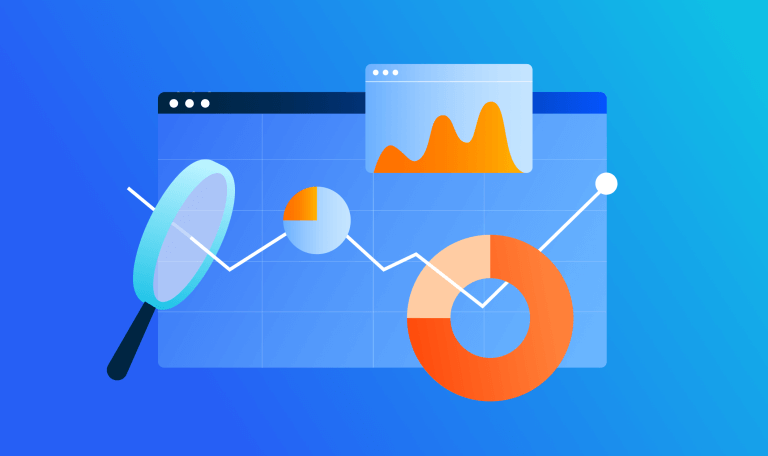What Is Benchmarking: The Ultimate Guide

Comparison is part of human nature. Think about the last time you ate a burger. Was it tasty? How tasty? You can only decide how good the burger was by comparing it to others you’ve eaten.
Comparison helps us understand relationships and make quality judgments. We compare different products (like burgers), and elements in our environment (like night versus day), and even compare ourselves to peers to determine our own merits (though maybe we should do less of this one).
Let’s face it, we’re benchmarking everything all the time! While you may not call it benchmarking when you eat a burger and think it wasn’t quite as delicious as the last one, it’s exactly what you were doing. Who knew you were already such a benchmarking expert?
Now that we’ve got the basic benchmarking definition out of the way, it’s time to focus on benchmarking in business, its benefits, the different types, and how it’s done. So sit down and buckle up, because here we go!
What is benchmarking and what does it mean in business?
Benchmarking is defined as the process of comparing and measuring different businesses’ activities and performances. It’s a great way to evaluate performance, determine industry best practices, and identify opportunities for improvement.
Studying other companies that may have superior performance will give you insight into their activities, processes, goals, and metrics. By comparing your findings to your brand’s performance, you can set realistic goals and create a plan to achieve them.
What are the benefits of benchmarking?
There are numerous benefits of benchmarking. Not only will you understand your competitors, but you’ll also be able to:
1. Spot trends and opportunities: Being able to identify trends can keep you from getting blindsided by a shift in your industry. With benchmarking, you’ll know exactly what your competitors are doing and be able to make the most of opportunities in real time.
Pro Tip: The Similarweb Identify Industry Trends tool will allow you to analyze how demand and interests change in your industry.
2. Know your potential: Do you know what similar companies are achieving? What’s realistic for you to achieve? Benchmarking can help you understand your growth potential and identify areas where you can expand.
Pro Tip: Use the Similarweb Analyze Industry Leaders tool to see your top-performing competitors’ achievements and benchmark your potential.
3. Track your market position: It’s important to understand how you compare to competitors. Benchmarking can reveal your position in the market and analyze the competitive landscape. Monitoring market changes will let you know if your activities are successful or if you need to pivot.
Pro Tip: Tap into the Similarweb Industry Overview tool to get a bird’s eye view of your industry and industry-wide metrics.
4. Improve strategic planning and goal-setting: Basing your strategic planning and goal-setting on benchmarks ensures that you’re working toward relevant and realistic goals.
What are the different types of benchmarking?
There are several types of benchmarking and each is important for your business.
Competitive: Competitive benchmarking is about staying on top of what your competition is doing. Let’s say your company is developing software and all your competitors suddenly develop a similar feature – you’d be wise to tap this trend and develop this feature too.
Strategic: Strategic benchmarking is the process of understanding which business models are best for strategic success. Prime example: If an organization is looking to develop a new marketing strategy, it may benchmark against the digital marketing strategies of companies it admires.
Performance: Performance benchmarking includes collecting quantitative data and other key performance indicators. A performance benchmark analyzes a company’s revenue, costs, or number of sales. Performance benchmarks can be made by looking at your own company’s data or competitors’.
Digital: Digital benchmarking is performance benchmarking for web activity. It can help you assess your activity’s impact and potential. For example, you might benchmark your engagement rate, bounce rate, or amount of unique visitors to determine whether these metrics align with industry standards.
Practice: Practice benchmarking evaluates practices and processes for optimization. It can include looking at processes or workflows within your organization, or at how competitors complete similar activities. Let’s say you’re experiencing delays in posting regular content on your website. You can benchmark your content creation and approval process to identify areas of improvement in your content marketing strategy.
Internal: Benchmarking is not only against the competition. You might do internal benchmarking to compare similar time periods in the past and future or compare different projects or departments.
External: External benchmarking is about analyzing areas outside your business. These could be competitors, industry standards, or anything else that might be relevant. Competitive, strategic, and digital are generally forms of external benchmarking.
How do you do benchmarking?
You already know the concept of benchmarking. Now let’s break down how it’s done.
1. Plan
Your first step is to decide exactly what you’re looking for and why you’re benchmarking. Here you can decide which type of benchmarking you’ll use, the subject of your benchmarking, and what you plan to do with your benchmark.
Start by deciding if the benchmark is internal or external. If it’s internal, you need to pick which processes, practices, or metrics you’ll analyze. If it’s external, which companies will you look at?
Next, you want to understand the purpose of the benchmark. Are you looking to improve something? Create a new goal? Better your understanding of the market?
Answering all of these questions will help you focus on collecting relevant information while you benchmark.
Read More – The 6 Benchmarking Questions Every Organization Needs to Ask
2. Collect
Now that you know what you’re looking for, it’s time to gather data.
If you’re creating an internal benchmark, you’ll look to your employees, colleagues, and website analytics tools to provide qualitative and quantitative information about the topic of your benchmark. If it’s an external benchmark, you’ll start researching competitors.
External benchmarking can be challenging because many companies don’t make their data public. Get creative to get the answers you need. For example, you could put yourself through your competitors’ sales funnels to understand their processes, focus, and how they nurture their leads. You could also talk to your competitors’ customers or maybe even their former employees to find out about their experiences.
If you’re looking for quantitative data such as performance or digital metrics, you can use tools such as the Similarweb Market Intelligence Platform to gather insights not available elsewhere.
At this point, you want to collect as much data as possible. Write everything down and keep every piece of information you gather because you may not realize what’s important yet.
3. Analyze
Once you feel you’ve exhausted all avenues for acquiring data, it’s time to organize and analyze. If you’re performing quantitative market research by analyzing quantitative data, create graphs or charts that will allow you to easily compare the data points.
Plot your own metrics on the same graph as your competitors’ metrics to see how you stack up, and for qualitative data, review for themes or interesting ideas that stand out. You can create diagrams or mind maps to organize the information and highlight pertinent points. If you’re analyzing processes, simply map them and look for any bottlenecks or opportunities for streamlining. You can even map similar processes together to analyze for differences and ideas for improvements.
Organizing all your data will help you identify trends, gaps, opportunities, and themes, not to mention gain a great understanding of your company’s position overall.
Here’s a quick example. Using Similarweb Website Performance, let’s benchmark popular brand websites target.com, walmart.com, and kohls.com.
Unsurprisingly, industry mogul walmart.com leads in monthly visits and unique audience. Interestingly, kohls.com sets the standard in terms of visit duration, pages per visit, and bounce rate. All three of those metrics are key in determining the quality of traffic a website receives.
So, in this case, if you were target.com, you’d want to look at how both of those competitors are driving traffic. Walmart.com’s marketing channels are driving higher quantities, but kohls.com’s channels are driving higher quality traffic.
This information will not only give target.com a good way to compare its own traffic metrics but also help the team dig into opportunities to improve.
4. Implement
You probably came up with tons of ideas while analyzing your data. Maybe you saw a process that could easily be streamlined or noticed metrics that were ripe for improvement, or you identified a useful strategy from a competitor that you’re eager to try out. That’s all great!
Now you need to put your findings into action. This means developing a list of action items you’d like to implement. You’ll have to prioritize and figure out which changes will bring about the most benefit for your organization. You might want to chart all the opportunities you identified to determine which to implement, based on which will bring the most value for the effort required.
Don’t worry if you can’t implement all your activities at once. Choosing a few to focus on will actually improve your likelihood of success. You can also come back to other opportunities when you have the bandwidth.
5. Monitor
So, was your benchmark successful? You’ll only know by monitoring. Are you set to reach your goals? If not, go back to your analysis and figure out what to change. You also want to keep monitoring your benchmark to see changes in the data.
Different types of data may require different frequencies for monitoring. For example, processes or strategies can probably go a few quarters without being looked at, but digital and performance metrics should be checked more often.
What tools can I use for benchmarking?
A sound benchmark requires tools that provide reliable and timely data. Similarweb has multiple tools that can help you create top-notch benchmarks:
- Market Intelligence: Explore your market, discover industry trends, analyze competitive performance, and understand audience behavior
- Benchmarking Tool: Gather digital data to identify high-value opportunities, track your performance, and win your market.
- Company Research Tool: Understand how competitor websites and apps are performing to reveal any company’s digital footprint and growth into new markets.
- Market Research Tool: Analyze consumer trends within your market, become an industry insider, and grow your digital market share.
- Audience Insights Tool: Analyze consumer behavior, better engage your existing audience, and explore new digital strategies for growth
- Conversion Funnel Analysis: Uncover competitor strategies and performance metrics down to the purchase level, to better define your digital strategy and unlock your full potential.
On your benchmark, get set, go!
So there you have it. Benchmarking is key for continuous improvement in your business. You’ll find that setting goals and tracking progress have never been easier. And better yet, you’ll succeed in achieving those goals. So get out there and benchmark!
FAQ
What does benchmarking mean?
Benchmarking is all about comparison and identifying best practices within your organization or against others in your industry. Understanding how you stack up helps you set goals, identify opportunities, and improve your business.
What is benchmarking in business?
Benchmarking in business is the process of comparing different business activities. You can benchmark strategies, metrics, processes, and more to gather insights on how you can improve.
Benchmark like a boss with fresh competitive data
Contact us to set up a call with a market research specialist















